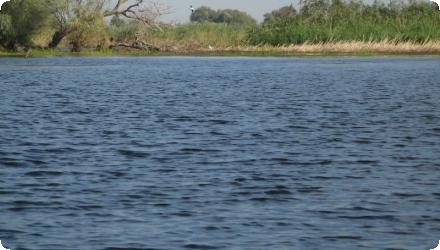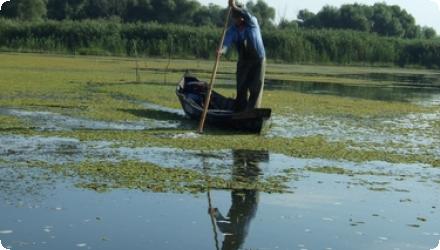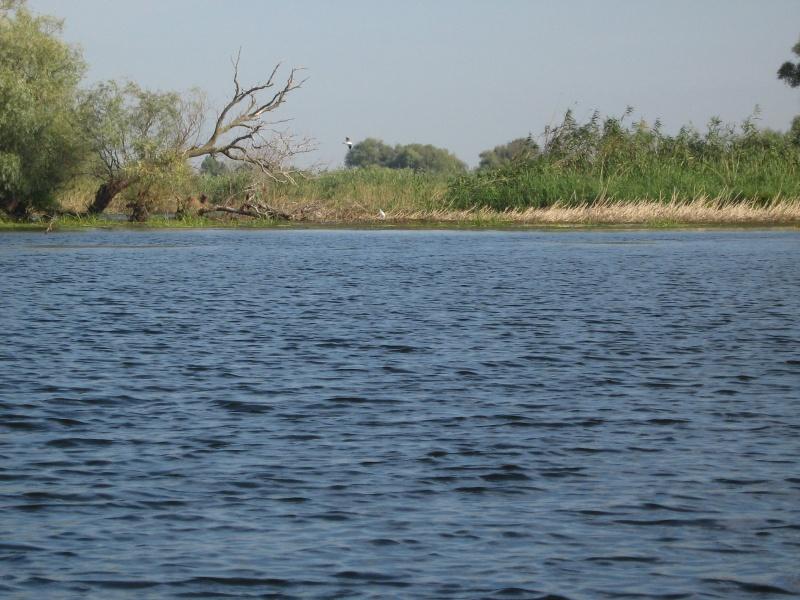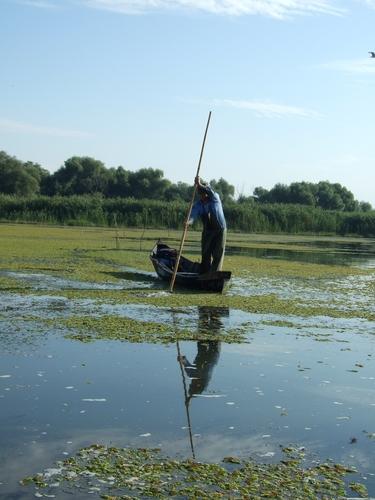Last update
2025
Summary
The Danube Delta Biosphere Reserve Authority’s Fortuna Wetland Restoration Project reconnected the 2,115-ha agricultural polder “Fortuna” to the Danube, restoring the hydrological regime and functions (works completed in 2004). Since then, restoration has scaled up across the Șontea–Fortuna complex. In 2015–2017, the EEA-funded RESTORATION-DD project dredged 13.56 km of secondary channels to re-establish habitat connectivity and migration routes, with monitoring and outcomes reported for c.7,000 ha within the 24,636-ha hydrographic unit. From 2021 onward, ARBDD is implementing a multi-site POIM project (SMIS 2014+ 120889) to improve hydrological conditions in Șontea–Fortuna, Matița–Merhei and Somova–Parcheș; planned works include the Fortuna Canal (5,176 m) among other links, with public communications indicating ~156 km of channels across the complexes. In 2024, environmental procedures were filed for desilting Lakes Fortuna and Uzlina, signalling continued management of water circulation and eutrophication control.
Position
Latitude
45.191111
Longitude
29.148056
Project
NWRM
National Id
Romania_03
Installation date
2004-11
Implementation Status
Contact
Bogdan Barbu, RECImola Koszta, REC
RBD code
RO1000
Transboundary
0
Photo gallery
Location of the project
In the Șontea–Fortuna lacustrine complex (Tulcea County), west-central Danube Delta, between the Sulina (south) and Chilia (north) branches; near Tulcea.
NUTS Code
RO22 - Sud-Est
Project's objectives
Reconnect the 2,115-ha “Fortuna” agricultural/forestry polder to the Danube regime to restore the natural hydrological regime and functions.
Protect and maintain populations of species and habitats of high ecological value.
Carry out restoration works where the natural/semi-natural character had been lost.
Manage water circulation to improve ecological conditions (e.g., re-establishing connectivity and flow patterns).
Assess the effectiveness of existing buffer zones and recommend modifications if needed.
Protect and maintain populations of species and habitats of high ecological value.
Carry out restoration works where the natural/semi-natural character had been lost.
Manage water circulation to improve ecological conditions (e.g., re-establishing connectivity and flow patterns).
Assess the effectiveness of existing buffer zones and recommend modifications if needed.
Involved Partners
| Authority type | Authority name | Role | Comments |
|---|---|---|---|
Climate zone
warm temperate dry
Temperature
11,2
Precipitation
400
Elevation range
12
Vegetation class
Reedbeds (Phragmites australis) dominate marsh vegetation across the Danube Delta, including the Sontea–Fortuna area, with adjacent aquatic macrophytes in lakes.
Water bodies: Ecological Status
Good
Water bodies: Chemical Status
Good
Water quality status
Delta-wide reports note water-quality deterioration and eutrophication pressures.
Project scale
Micro
Project scale specification
The original case study targets a single site - the 2,115-ha Fortuna polder - reconnected to the Danube to restore its hydrological regime (works completed in 2004). That’s a localized hydromorphological intervention within the Șontea–Fortuna complex.
Performance timescale
Immediate
Project area
2115
Area subject to Land use change or Management/Practice change (ha)
2115
Lifespan
50
Hydrotechnical measures tailored to maintain connectivity at low water (e.g., dredging 13.56 km of secondary channels).
The villagers in Gorgova have strongly opposed the measure of closing channels leading to the Lake Fortuna, because it makes access by boat more difficult for them.
Total cost
unknown
Costs total information
Early restoration framework (Danube Delta Biodiversity Project, 1994–2000) : US $4.50 million. Financing: GEF/World Bank US $4.30 m; Government of Romania US $0.20 m.
Fortuna reconnection works (2004) – “original” NWRM case : reconnection of Polder Fortuna (2,115 ha)No public figure
RESTORATION-DD (EEA Grants, 2015–2017)
Final project cost: €1,322,185. EEA Grants contribution: €1,123,857. (Implied co-financing difference: €198,328
1994–2000 enabling project (incl. early polder work): US $4.50 m total — US $4.30 m GEF/World Bank, US $0.20 m Romania.
2004 Fortuna reconnection: no public cost found; financiers named (Ministry + World Bank).
2015–2017 RESTORATION-DD: €1,322,185 total — €1,123,857 EEA Grants (+ €198,328 other co-finance not detailed on the public page).
2019–2023 POIM SMIS 120889 (covers Sontea-Fortuna among complexes): RON 35,910,901.99 total — at least RON 30,524,266.72 ERDF and RON 538,486.60 state budget documented; remainder/beneficiary share unclear in public pages.
Fortuna reconnection works (2004) – “original” NWRM case : reconnection of Polder Fortuna (2,115 ha)No public figure
RESTORATION-DD (EEA Grants, 2015–2017)
Final project cost: €1,322,185. EEA Grants contribution: €1,123,857. (Implied co-financing difference: €198,328
1994–2000 enabling project (incl. early polder work): US $4.50 m total — US $4.30 m GEF/World Bank, US $0.20 m Romania.
2004 Fortuna reconnection: no public cost found; financiers named (Ministry + World Bank).
2015–2017 RESTORATION-DD: €1,322,185 total — €1,123,857 EEA Grants (+ €198,328 other co-finance not detailed on the public page).
2019–2023 POIM SMIS 120889 (covers Sontea-Fortuna among complexes): RON 35,910,901.99 total — at least RON 30,524,266.72 ERDF and RON 538,486.60 state budget documented; remainder/beneficiary share unclear in public pages.
Financing authorities
Type of funding
Other
Type of funding
National funds
Compensations
0
Land ownership
Public domain of county interest administered by Tulcea County Council
Community involvment
No
Design consultation activity
| Activity stage | Name | Key issues | Comments |
|---|
Policy target
| Target purpose |
|---|
|
Improved Biodiversity
|
|
Oher Societal Benefits
|
Policy pressure
| Pressure directive | Relevant pressure |
|---|
Policy impact
| Impact directive | Relevant impact |
|---|
Requirement directive
| Requirement directive | Specification |
|---|
Contractual arrangements
0
| Arrangement type | Responsibility | Role | Name | Comments |
|---|
Part of wider plan
1
Wider plan type
| Wider plan type | Wider plan focus | Name | Comments |
|---|---|---|---|
|
Local
|
Environment & Biodiversity
|
The Rehabilitation Programme
|
Wetland Restoration Projects
|
|
Environment & Biodiversity
|
Danube Delta Biodiversity Project
|
Periodic, seasonally tuned campaigns should capture hydrological, physico-chemical (pH, N, P) and biological data on Fortuna and connected channels, with outputs integrated in GIS/habitat-status assessments to support management decisions.
Water-level/flow monitoring on the Danube branches and on the feeding/drainage channels of Lakes Fortuna and Uzlina, alongside water-quality indicators—pH, inorganic nitrogen, orthophosphate, total phosphorus—and biological components such as zooplankton
Maintenance
Ongoing desilting and channel re-calibration led by ARBDD—e.g., Canal Fortuna 5.176 km and Gârla Șontea 11.949 km—plus a 2024 desilting project for Lakes Fortuna and Uzlina.
Closing some access channels from Gorgova/Maliuc reduced boat access to Lake Fortuna, increasing travel time/costs and creating local conflict (reported as a social/operational impact during the restoration context).
Direct livelihood benefits listed for this site: fish yield, reed harvest, tourism, cattle.
Tourism use of the area: county materials present Lake Fortuna as a bird-watching/fishing destination on standard routes
Direct livelihood benefits listed for this site: fish yield, reed harvest, tourism, cattle.
Tourism use of the area: county materials present Lake Fortuna as a bird-watching/fishing destination on standard routes
Information on retained water
Connectivity restored (2004 core project; 2015–2017 extension): Re-established links between the polder/lakes and the main channel network, explicitly to secure connectivity even at low Danube water levels and to reopen migration routes for aquatic species.
~13.5 km of secondary channels were dredged; channel bottoms changed from about +1.0 m a.s.l. (in some sectors) to −1.5 to −2.0 m a.s.l. (per design), improving flow conveyance.
~13.5 km of secondary channels were dredged; channel bottoms changed from about +1.0 m a.s.l. (in some sectors) to −1.5 to −2.0 m a.s.l. (per design), improving flow conveyance.
Water quality overall improvements
Positive impact-WQ improvement
Information on Water quality overall improvements
Retention of sediments and pollutions; Black Sea biofilter.
Soil quality overall soil improvements
Positive impact-SQ improvement
Information on Soil quality overall soil improvements
Organic production; Biogeochemical circuit elements
1
- Habitat for plants and animals typical alluvial areas; - Habitat and breeding area for fish and aquatic birds; - Reservoir for biodiversity and providing genetic resources; - Biocoridor and genetic exchange; restoration of ~7,000 ha of fragmented wetland within the 24,636-ha Șontea–Fortuna unit; connectivity of habitats and migration routes restored under low-water conditions; conservation state restored for 7 aquatic habitat types (1 priority); and improved conservation status for >5,000 wild species
Ecosystem impact climate regulation
No information available
Key lessons
Local support is decisive. The initial reconnection reduced boat access from Gorgova/Maliuc to Lake Fortuna, raising costs and sparking conflict; future designs must co-create access solutions with residents.
Hydrological restoration is not “one-and-done.” The NWRM file flags that the restored area was not self-sustaining; subsequent programmes show recurring desilting and channel calibration (e.g., 2024–2025 works on Lakes Fortuna and Uzlina) to keep circulation and water levels within targets.
Evidence-led, adaptive management adds value. The EEA RESTORATION-DD phase produced 9 pre/post studies, GIS databases and a success-evaluation report, enabling adjustments and policy advice tied to ecosystem services.
Clear governance and financing pathways matter. The NWRM page records barriers—fragmented ownership/administration and weak inter-agency coordination—while later phases unlocked external windows (EEA Grants; ERDF/POIM) and international partnerships (DDNI–NINA) that helped scale work across the Șontea–Fortuna complex.
Design for low-water conditions is critical in the Delta. Works explicitly targeted restoring connectivity and migration routes under low Danube levels, a recurring stressor for cut-off lakes like Fortuna.
Hydrological restoration is not “one-and-done.” The NWRM file flags that the restored area was not self-sustaining; subsequent programmes show recurring desilting and channel calibration (e.g., 2024–2025 works on Lakes Fortuna and Uzlina) to keep circulation and water levels within targets.
Evidence-led, adaptive management adds value. The EEA RESTORATION-DD phase produced 9 pre/post studies, GIS databases and a success-evaluation report, enabling adjustments and policy advice tied to ecosystem services.
Clear governance and financing pathways matter. The NWRM page records barriers—fragmented ownership/administration and weak inter-agency coordination—while later phases unlocked external windows (EEA Grants; ERDF/POIM) and international partnerships (DDNI–NINA) that helped scale work across the Șontea–Fortuna complex.
Design for low-water conditions is critical in the Delta. Works explicitly targeted restoring connectivity and migration routes under low Danube levels, a recurring stressor for cut-off lakes like Fortuna.
Success factor(s)
| Success factor type | Success factor role | Comments | Order |
|---|---|---|---|
|
Successful coordination between authorities
|
main factor
|
A strong institutional anchor (ARBDD as implementer; DDNI as science lead) with defined roles. |
|
|
Financing possibilities
|
main factor
|
Dedicated external funding windows (EEA Grants; ERDF/POIM) to finance works beyond the initial site. |
|
|
Conducted assessments (incl. economic)
|
main factor
|
Robust pre/post monitoring and GIS mapping to steer adaptive management and inform policy. |
|
|
Conducted assessments (incl. economic)
|
secondary factor
|
Commitment to ongoing maintenance (recent desilting proposals for Lakes Fortuna & Uzlina). |
Driver
| Driver type | Driver role | Comments | Order |
|---|
Transferability
Transferable : Highly transferable to deltaic/floodplain polders with altered connectivity. Success hinges on clear governance and funding, robust pre-/post-monitoring, and designs that maintain flows at low water. Proceed with care on local navigation/access needs, permitting and land administration, and plan for recurrent maintenance (desilting/channel calibration) to avoid stagnation and eutrophication.
English




2015–2017: project promoter of EEA-funded RESTORATION-DD (dredging 13.56 km of secondary channels; 9 pre/post restoration studies, GIS databases).